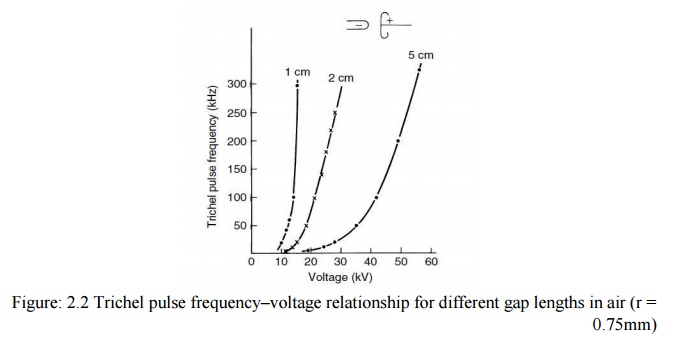Chapter: High Voltage Engineering : Electrical breakdown is gases, solids& Liquids
Corona Discharges
CORONA DISCHARGES
In uniform field and quasi-uniform field gaps the onset of measurable ionization usually leads to complete breakdown of the gap. In non-uniform fields various manifestations of luminous and audible discharges are observed long before the complete breakdown occurs.
These discharges may be transient or steady state and are known as ŌĆścoronasŌĆÖ. An excellent review of the subject may be found in a book by Loeb.
The phenomenon is of particular importance in h.v. engineering where non-uniform fields are unavoidable. It is responsible for considerable power losses from h.v. transmission lines and often leads to deterioration of insulation by the combined action of the discharge ions bombarding the surface and the action of chemical compounds that are formed by the discharge.
It may give rise to interference in communication systems. On the other hand, it has various industrial applications such as high-speed printing devices, electrostatic precipitators, paint sprayers, Geiger counters, etc. The voltage gradient at the surface of the conductor in air required to produce a visual a.c. corona in air is given approximately by the PeekŌĆÖs expression.
There is a distinct difference in the visual appearance of a corona at wires under different polarity of the applied voltage. Under positive voltage, a corona appears in the form of a uniform bluish-white sheath over the entire surface of the wire.
On negative wires the corona appears as reddish glowing spots distributed along the wire. The number of spots increases with the current. Stroboscopic studies show that with alternating voltages a corona has about the same appearance as with direct voltages. Because of the distinctly different properties of coronas under the different voltage polarities it is convenient to discuss separately positive and negative coronas. In this section a brief review of the main features of corona discharges and their effect on breakdown characteristics will be included. For detailed treatment of the basic fundamentals of this subject the reader is referred to other literature sources.
1. Positive or anode coronas
The most convenient electrode configurations for the study of the physical mechanism of coronas are hemi spherically capped rod-plane or point-plane gaps. In the former arrangement, by varying the radius of the electrode tip, different degrees of field non-uniformity can be readily achieved. The point plane arrangement is particularly suitable for obtaining a high localized stress and for localization of dense space charge. In discussing the corona characteristics and their relation to the breakdown characteristics it is convenient to distinguish between the phenomena that occur under pulsed voltage of short duration (impulse corona), where no space charge is permitted to drift and accumulate, and under long lasting (d.c.) voltages (static field corona).

Under impulse voltages at a level just above ionization threshold, because of the transient development of ionization, the growth of discharge is difficult to monitor precisely. However, with the use of ŌĆśLichtenberg figuresŌĆÖ techniques, and more recently with high-speed photographic techniques, it has been possible to achieve some understanding of the various discharge stages preceding breakdown under impulse voltages.
The observations have shown that when a positive voltage pulse is applied to a point electrode, the first detectable ionization is of a filamentary branch nature, as shown diagrammatically in Fig. 2.1(a). This discharge is called a streamer and is analogous to the case of uniform field gaps at higher pd values. As the impulse voltage level is increased, the streamers grow both in length and their number of branches as indicated in Figs 2.1(b) and (c). One of the interesting characteristics is their large number of branches which never cross each other. The velocity of the streamers decreases rapidly as they penetrate the low field region.
2. Negative or cathode corona
With a negative polarity point-plane gap under static conditions above the onset voltage the current flows in very regular pulses as shown in Fig. 2.2 (b), which indicates the nature of a single pulse and the regularity with which the pulses are repeated. The pulses were studied in detail by Trichel and are named after their discoverer as ŌĆśTrichel pulsesŌĆÖ.

The onset voltage is practically independent of the gap length and in value is close to the onset of streamers under positive voltage for the same arrangement.
The pulse frequency increases with the voltage and depends upon the radius of the cathode, the gap length and the pressure. The relationship between the pulse frequency and the gap voltage for different gap lengths and a cathode point of 0.75mm radius in atmospheric air is shown in Fig. 2.2. A decrease in pressure decreases the frequency of the Trichel pulses.
Related Topics